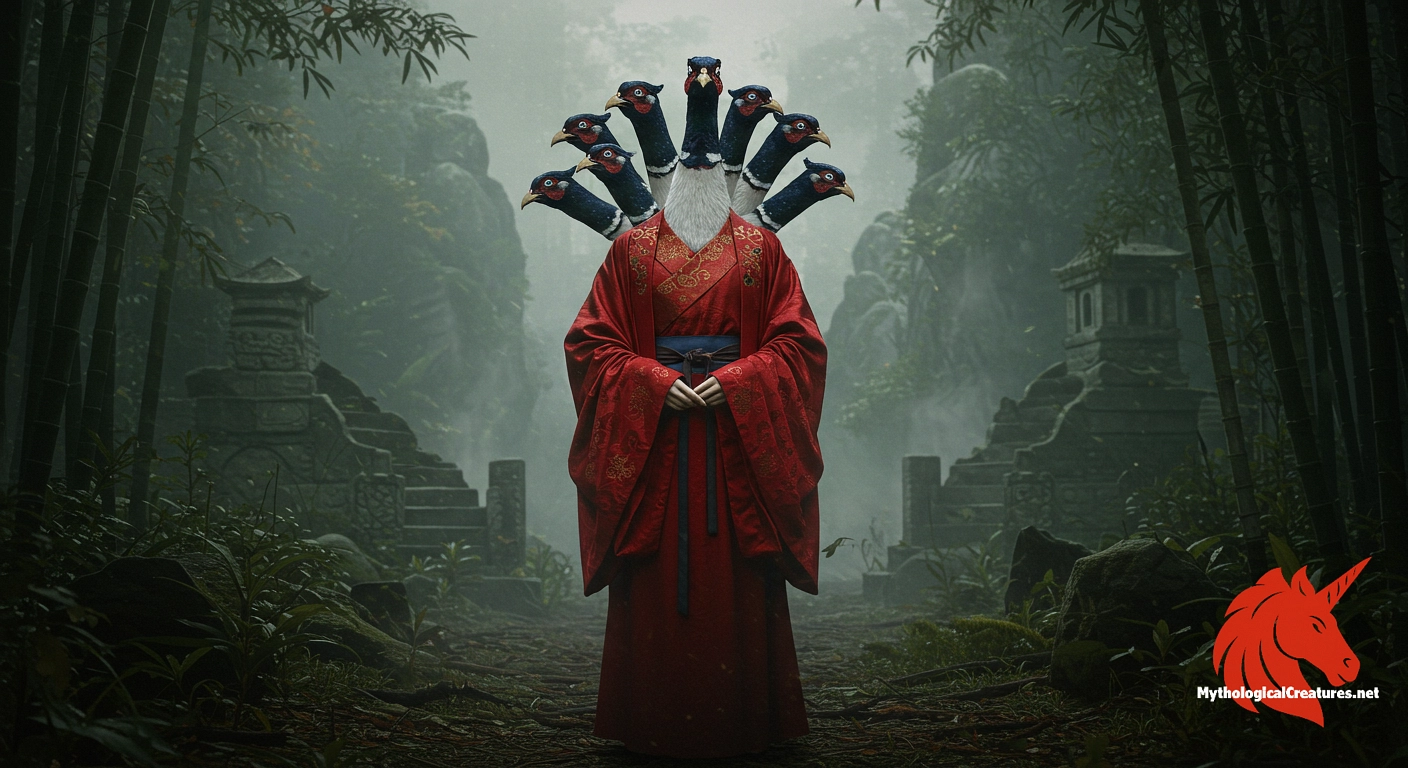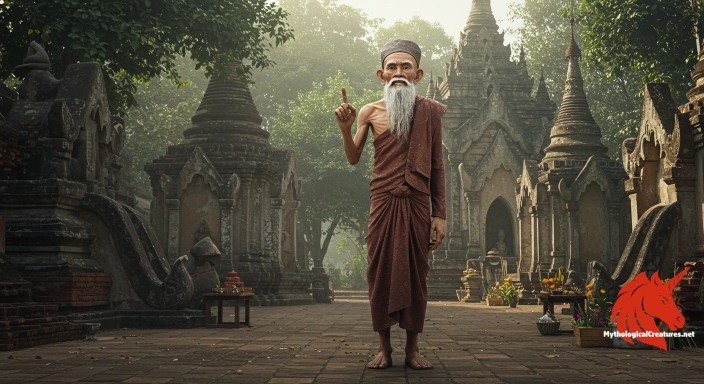Jiutou Zhiji Jing: Jiutou Zhiji Jing, also known as Hu Ximei, is a nine-headed pheasant spirit from the classic Chinese novel Investiture of the Gods.

Jiutou Zhiji Jing
Jiutou Zhiji Jing - Represents themes of transformation, deception, and downfall in mythological narratives
Origins & First Encounters
Jiutou Zhiji Jing is a captivating mythic figure whose origins lie in the realm of yaojing, beings that blur the line between nature and the supernatural. Her story emerges from the illustrious pages of Investiture of the Gods, where her transformation from a nine‐headed pheasant into a spectral spirit offers a vivid insight into ancient Chinese imagination. The melding of animal instincts with human-like seduction in her character reflects a deep cultural fascination with metamorphosis. Her narrative is interwoven with themes of beauty, deception, and the chaotic interplay of divine forces that govern mortal affairs. With every retelling, she embodies a delicate balance between allure and danger that has both bewitched and warned her audience. The rich tapestry of her myth situates her alongside other enigmatic figures, emphasizing the transformative power of both nature and the supernatural. Her early presence in classical texts hints at a complex role in court intrigues and celestial manipulations. Over time, Zhiji Jing has evolved into a symbol of transient beauty and moral ambiguity, inviting continuous reinterpretation. Rooted in the vibrant traditions of Chinese folklore, her legend endures as an emblem of the mysterious and multifaceted nature of myth. In every aspect of her portrayal, she reflects the ancient cultural belief in the unpredictable forces of change and fate.
Source Texts & Tale Variants
The story of Zhiji Jing finds its foremost expression in the classic narrative of Investiture of the Gods, where her spectral presence is both enigmatic and impactful. Her character has been a part of oral traditions and folk performances that further expand upon her role in myth and morality. Variations in the narrative have seen her portrayed with layers of tragic allure, emphasizing her survival amidst a disastrous confrontation with other spectral beings. Some accounts highlight her involvement in elaborate court intrigues, where the line between enchantment and deception becomes blurred. Later literary adaptations have enriched her character by introducing subtler nuances of seduction and duality. In dramatic retellings, she is sometimes depicted as the embodiment of both grace and peril, offering commentary on the transient nature of beauty and power. Local operas and storytelling traditions have incorporated her figure to explore themes of betrayal and the consequences of hubris. Each version of her story adds depth to the overarching mythos, ensuring that her tale remains dynamic and continually open to reinterpretation. These varied sources create a multifaceted portrayal that has allowed her legend to survive and evolve over generations. In every telling, Zhiji Jing’s myth reinforces the timeless appeal of enigmatic figures within the rich fabric of Chinese folklore.
Form & Powers
Zhiji Jing is portrayed with an enchanting physicality that merges the elegance of human form with the wild grace of her original pheasant nature. Her nine heads, each reminiscent of a splendid pheasant’s plumage, hint at the multifarious aspects of her identity and the transformative power she holds. Clad in a large red robe that flows dramatically, her attire is both conspicuous and symbolically potent, evoking passion and caution in equal measure. The silk sash gracefully tied around her slim waist not only accentuates her delicate figure but also underscores a blend of sophistication and the supernatural. Her small red linen shoes add a subtle touch of traditional charm, hinting at the careful balance between her earthly and spectral qualities. The vivid imagery of her eyes, described as mirroring an autumn lake, captures a depth of emotion and a hint of inscrutable mystery. Artists and storytellers have often highlighted how these features work in concert to present a figure of both ethereal allure and latent menace. The detailed physical descriptions underscore the duality of her existence—beautiful yet dangerous, worldly yet otherworldly. Such depictions have allowed her to remain a striking subject in both traditional art and modern portrayals. Her appearance stands as a testament to the elaborate care with which mythological beings are crafted, merging aesthetics with the symbolic weight of her destiny.
Regional Faces
Across various regions in China, the legend of Zhiji Jing has morphed to mirror local artistic styles and cultural priorities. In some northern retellings, her image takes on a more untamed and rugged quality, aligning her with the raw forces of nature and the relentless pace of life on the fringes. Southern interpretations, on the other hand, often stress her tragic beauty and the refined, almost melancholy elegance that marks her interactions with mortal realms. Regional adaptations sometimes emphasise her role as a seductress with a hidden agenda, reflecting local concerns about the corruption of power. Rural folklore has interwoven her story with indigenous rituals and seasonal celebrations, further diversifying her character. Local storytellers and theatrical troupes have contributed to an evolving image that not only depicts her as a bewitching spirit, but also as a cautionary example of volatile beauty. The variations in her portrayal serve to highlight how different communities negotiate the interplay between mortal vulnerability and supernatural potency. Cultural exchanges and regional festivals have often embraced her myth, allowing for reinterpretations that resonate with unique local traditions. Through these regional lenses, Zhiji Jing becomes a versatile figure whose core narrative adapts fluidly to the values and aesthetics of each community. This regional dynamism underscores the universal appeal and adaptability of her enduring legend.
Cultural Parallels
Zhiji Jing invites a fascinating comparative analysis with other mythological entities whose narratives also blend seduction, transformation, and inherent danger. Her portrayal as a multi-headed, shape-shifting being finds echoes in various traditions, where creatures possess compounded forms to symbolise complexity. Within Chinese mythology, she is often discussed alongside figures like Pipa Jing and fox spirits, each portraying facets of allure and unpredictability. Similar themes are noted in other cultures, where multi-headed creatures such as the Hydra or Cerberus, albeit with different moral dimensions, illustrate the narrative of multiplicity and chaos. Japanese folklore, with its rich tradition of enchanting shape-shifters like the nine-tailed fox, shares an affinity with the motif of seductive yet ominous beauty. The alluring defiance embodied by Zhiji Jing is reminiscent of other supernatural beings whose beauty masks a darker, more dangerous nature. Furthermore, the motif of transformation from animal to spirit underscores a common cultural thread that spans both Eastern and Western mythologies. Such parallels highlight a shared human fascination with characters that oscillate between the natural and the divine. By cross-examining these diverse mythological figures, one can appreciate a universal desire to articulate the fine line between temptation and peril. In essence, her character not only aligns with, but also enriches, the broader global narrative of ethereal, shape-shifting seductresses.
Legacy & Modern Evolution
Over time, the depiction of Zhiji Jing has undergone significant evolution, reflecting broader cultural shifts and the changing values of society. Her original portrayal in classical literature as a bewitching and dangerous yaojing has matured into a more layered figure whose narrative resonates with modern audiences. Contemporary adaptations frequently reframe her as a tragic heroine whose allure intertwines with themes of moral compromise and the burdens of seduction. Modern media, including film, television, and graphic novels, have reimagined her story to explore complex questions of identity, power, and vulnerability. The transformation in her portrayal mirrors a wider reassessment of traditional myth, where characters are unpacked to reveal nuanced commentaries on gender and societal expectations. Artistic renditions today often highlight her internal conflict and the duality of her existence, blending historical iconography with innovative narrative twists. Zhiji Jing’s enduring allure lies in her ability to serve as both a symbol of ancient mysticism and a canvas for modern reinterpretation. Her narrative has become a rich source of inspiration for creators who wish to explore the boundaries between beauty and danger. The continuous interest in her story underscores the timeless nature of myth and its capacity to adapt to new cultural discourses. In every modern retelling, she remains a potent symbol of the intricate dance between enlightenment and decadence, preserving her place in the landscape of enduring folklore.
Interesting Fact
An intriguing aspect of Jiutou Zhiji Jing is her dual existence, seamlessly blending the raw power of a multi‐headed pheasant with the refined allure of human beauty, which mirrors the complex duality often seen in Chinese mythological figures.
Quick Creature Info
Associations:
Our Mythic Legendary Rating:

Also Sometimes Known As:
Habitat:
Supernatural Powers:
Physical Attributes:
Abilities:
Behavior:
Lore:
Related Creatures, Tales or Lore
- DDaji
- PPipa Jing
- HHuli jing
References
Discover Another Mythical Legend You May Not Have Heard Of?
Uncover the mysteries of ancient folklore and expand your knowledge of legendary beings from cultures around the world.
Dare to Meet the Bo Bo Gyi....
Mythical Disclaimer: The images and data on this site are derived from various historical and literary sources, but we have found that many myths often have multiple versions and interpretations across references, sometimes contradictory. As a result, these creature depictions are artistic interpretations—imaginative blends of folklore, legend, and a dash of AI guesswork. Because creature descriptions vary widely, our illustrations and accompanying information represent our best effort to honor mythology while bridging creative gaps. Enjoy these interpretations—just remember, we've done our best to respect the stories and validate available data, but in the realm of mythology, details often shift, imagination leads the way, and nothing is ever set in stone!
Curated by the Mythological Creatures Team (rev. May 2025)
